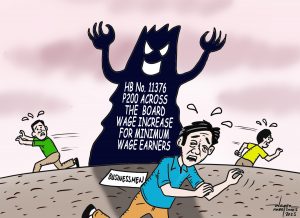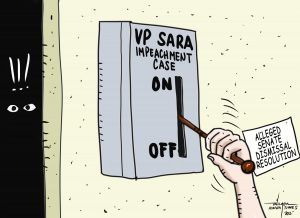LAST Tuesday we came across a post on Facebook a segment of a local television report detailing positions of some people including an executive of a Samal Island beach resort, on the forthcoming construction of a multi-billion peso bridge that will connect that city with mainland Davao.
Both the environmentalists and the resort executive emphatically said that they are not against the construction of the bridge and that they know its big impact on the island city’s economy when completed.
For the environmentalists though, their concern is the certainty of the destruction of existing reefs as well as the massive coral formations in the waters that divide the two cities. They claimed that the route of the bridge designed by a Hongkong-based consultant will cut across the Paradise Reef that hosts the growth of mangroves and pagatpat trees, and can be seen during low tide.
Lined along the reef are coral growths that stretches to almost the whole Samal island perimeter. All these God-given resources located on the bridge’s route, they claimed, will be destroyed and will have no way of being restored.
Thus, the environmentalists insisted that the decision of the government in determining the final location of the bridge is a total disregard to global mantra today which is to preserve the present status of the environment and implement measures to stop its further deterioration, and if possible restore it to what is ideal.
Unfortunately, according to the environmentalists interviewed, the planners of the Davao-Samal Bridge project appeared to have ignored the environmental issue and are reported bent on starting the bridge construction in the name of development.
On the other hand, the top executive of Paradise Island Beach Resort, the pioneering tourism-related business establishment if the island city, expressed his utter dismay at the lack of consideration of the Department of Public Works and Highways (DPWH) and the government for that matter, in agreeing with the route recommended by the Hongkong-based consultant.
According to Narciso “Sisoy” Rodriguez, the man behind Paradise Island Resort, the bridge planner totally ignored the ill-effects of the bridge route to his resort and the lives of many people who are making a living directly or indirectly, from its operation.
Yes, we can understand the lamentation of Mr. Rodriguez. After sinking in huge investment to make his resort worthy of local and foreign tourists’ visit, all its enticements, specifically the alluring beach water and the scenic view of mainland Davao and Davao City, will be disturbed.
And assuming that after the construction of the bridge cutting across the Paradise Beach area, there will still be some semblance of a resort left, the possibility is that it will now become a “resort under the bridge.” There surely will be distractions of attention among resort goers, if there will still be any.
Seemingly holding off his emotion during the interview by the television crew, Sisoy Rodriguez somehow gnashed his teeth at what he believes a row deal given his establishment by the DPWH. From our own reading of Mr. Rodriguez’s lines and what is in their in-betweens, we could sense that their position on the bridge route was not entertained during the supposed public consultations on the project.
We have no doubt that the government is ready to compensate the resort owners for whatever destruction the project would bring to the establishment. Things like the land affected, the resort buildings, and perhaps the loss in income while the establishment is shut down in the duration of the bridge construction on its site.
But for us who know personally the character of the Rodriguez family and their history of philanthropic deeds, we are certain that the value of their land that may be affected by the project is immaterial.
What we believe could be the primary cause of the protestation is the lack of wisdom in the decision of the project planners to have the Samal approach cut across their area. The Paradise Resort owners know that when the construction of the bridge component on top of its area begins, it has to stop the resort’s operation.
When this happens its employees will immediately lose their job. And those island city residents whose livelihoods are also dependent on the resort operation like the souvenir item producers and vendors, fish, meat, vegetable and sea shell suppliers, the entertainers, they’d surely end up losing their major client.
And what about the separated employees? Who will shoulder the payment of their separation pay? Will the DPWH assume that responsibility? Or will that government agency just let the resort owner take care of footing that labor-related bill?
We have no iota of doubt that the Rodriguez family can survive even without their Paradise Resort. But we are also certain that they will have a very heavy heart seeing their employees and those who make a living out of their resort’s operation losing food on their table; pulling their children out of school because they do not anymore have income to sustain their education.
For now we do not know if the owners of Paradise Island Resort still hope to have the bridge route changed. What we know is that the government has already made some pronouncements that construction will begin either late this year or early next year.
Meaning, it is already set to implement the project and has not seen any hindrance for it to start. If there is any, we presume that the government is not anymore entertaining such objection.
But we can see the tenacious desire of the resort owners as well as that of the environmentalists to continue with their effort to have their cause heard by the DPWH, even this late.
We can only hope that the decision makers give a little opening in their ears for them to hear those who have reservations on the Samal Island-Davao mainland bridge project.




